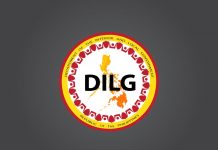The Department of the Interior and Local Government (DILG)-Recovery Assistance for Yolanda has finally received the recognition it deserves as one of the three best projects in the Philippines for its huge efforts in post-Yolanda rehabilitation in disaster-stricken areas during the 13th Japan International Cooperation Agency (JICA) President Award recently.
Speaking in-front of the DILG employees during the Monday morning flag-raising ceremony at the DILG-NAPOLCOM Center, DILG Undersecretary for Local Government Austere A. Panadero expressed his gratitude to JICA for acknowledging the DILG-RAY project as one of the three best projects out of the nine awardees in the country and out of the thousands of JICA projects all over the world.
“On behalf of the DILG, maraming salamat sa mga naging kabahagi ng RAY Project sa kanilang partisipasyon, pakikibahagi, at pagtutulugan upang magtagumpay ang pagbangon ng ating mga mahal na kababayang apektadong ng bagyong Yolanda,” Panadero added.
The DILG Undersecretary received the award in behalf of the Department at the recently concluded JICA awarding ceremony at RCBC Plaza, Makati City.
The annual JICA President Award honors projects, experts, consultants or volunteers for their outstanding achievements in various areas including human resource development, livelihood improvement, poverty reduction, and infrastructure development in developing countries.
The citation, which was signed by JICA President Shinichi Kitaoaka, states that the DILG’s Project on Rehabilitation and Recovery from Typhoon Yolanda is recognized for “its outstanding contribution to the development of human resources, society and the economy in the Philippines, and to the enhancement of friendly relations and mutual understanding between Philippines and Japan”.
JICA-funded municipal halls in Samar
In 2014, the government of Japan through JICA granted a financial aid to the Philippines amounting to JPY 480,000,000 (PhP224,680,009) in 2014 for the reconstruction of municipal halls in Lawaan, Eastern Samar and Marabut, Samar integrating the Build Back Better principle.
For the reconstruction in Marabut, the work involved a two-storey reinforced concrete municipal office with Politi system, a free ground floor to prevent high tide flood water from coming inside the 2,256.05 sq.m. municipal building. Meanwhile, the municipal office in Lawaan is a single storey reinforced concrete structure for the 1,095.78 sq.m. facility.
Both the municipal halls in Marabut and Lawaan are designed with disaster resistant structures and also serve as emergency evacuation centers for the local residents.
At present, the municipal hall in Lawaan is substantially complete (98%) and is expected to be turned over to the local government unit within the first quarter. Meanwhile, the municipal hall in Marabut is now 73.47% complete and is expected to be completed by the end of the second quarter.
While the DILG is the responsible agency for the project, it is the Department of Public Works and Highways (DPWH) which is the primary implementing agency for the two JICA- sponsored municipal halls.
Thousands of DILG project completed
Aside from the two JICA-funded municipal halls, Panadero said that the Department completed about 5,000 locally-funded projects throughout the Philippines in 2017 alone under the Performance Challenge Fund (PCF), Sagana at Ligtas na Tubig Para sa Lahat (SALINTUBIG), Payapa at Masaganang Pamayana (PAMANA), Assistance to Disadvantaged Municipalities (ADM), Conditional Matching Grant to Provinces (CMGP) for Road Repair, Rehabilitation and Improvement Program, among others.
“More than the numbers, let us think of all the people at the countryside whose lives we have positively changed through our DILG projects,” Panadero said.
The DILG Undersecretary narrated that while he was in travelling in Samar a week ago, an elderly person came up to him to thank the DILG potable water supply project which now allows her to take a bath at least once a week. Water supply system was unheard of in the past and the people relied mainly on the flowing river for their needs. Before the project came into being, residents in this community had to hike for more than 30 minutes just to fetch water for domestic use.
For this 2018, Panadero challenged all DILG personnel from the Central Office down to the farthest municipality in the country. “Let’s all help to bring out the change we want to see,” he said.



